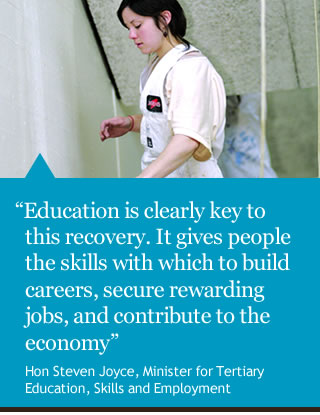Post-compulsory education
Relative to its population, the tertiary education sector in Canterbury is larger than Wellington or Auckland. Three tertiary education institutions (TEIs) are based in Christchurch; another university, three more polytechnics, and a wānanga extend the range of courses on offer. The private tertiary sector is also large and, prior to the earthquakes, the number of international students in the region was second only to Auckland.
This part of the sector has also experienced very significant damage as a result of the earthquakes. The three TEIs face a combined repair cost of around $300 million. Almost all providers have had to close buildings and face a substantial gap between the cost of repairs and rebuilding and insurance payouts they receive. Numerous CBD-based private providers are operating out of makeshift premises.
Enrolments for 2011 dropped significantly and, while early indications are that the 2012 intake of students at the Christchurch-based institutions will be up slightly, they are still likely to be around 5% to 10% down on 2010. International enrolments continue to fall.
As we plan for education renewal, TEIs need to address this broader economic challenge by looking at how they service the skill needs of the local market.
Looking to the future of post-compulsory education
Tertiary education has a key role to play in supporting the recovery of the region, both economically and socially. For this to occur, we need to anchor and stabilise the network and restore its viability.
And we need to ensure alignment between the strengths of institutions and the needs of the economy.
Success breeds success: young people who have more skills have more choices in terms of career path and are better able to take advantage of further training.
Skills open pathways to autonomy and self-efficacy.
It is imperative, therefore, that all our young people are studying and/or in work.
Ensuring this is the experience of all young people across greater Christchurch will mean making better use of the complementary strengths of secondary schools, TEIs, industry training organisations, and private tertiary providers.
The following actions will help address the challenges for post-compulsory education in greater Christchurch:
- Exploring greater collaboration between tertiary providers.
- Ensuring sustainability of provision.
- Enhancing coordinated leadership of the post-compulsory education system.
- Improving secondary-to-tertiary initiatives and education-to-work transitions.
- Continuing to cater for priority groups.
- Building on existing tertiary initiatives to meet the vocational and economic priorities of Canterbury.
You can learn more about these proposals around post-compulsory education [PDF; 881kb] in the Education Renewal Recovery Programme which has informed the development of a plan for renewal that will improve the delivery of education, extend the options available for learners, and lift student achievement.
We have also provided some resource material, including maps and background information, that should help you better understand the situation we find ourselves in to help inform your comments.
The Education Renewal Recovery Programme also makes proposals around the future of early childhood education, schooling and international education.
